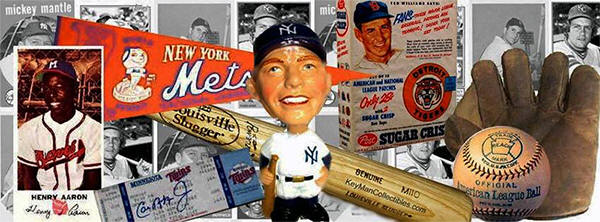| |
This is a Rawlings No. R1
"Professional Base Ball Fund" baseball
that was made
for the WWII "Baseball Equipment
Fund" headed by Clark Griffith in
1942. Along with the No. RO, "Cork
Center," the No. R1 Duo-Center, Official League ball was the highest quality baseball in the
Rawlings catalog, made
to the exact specifications of the
National Commission of Baseball
Leagues. The "Duo Center" Baseball was
patented and manufactured by the J.H.
Grady Manufacturing Co. a subsidiary of
Rawlings Sporting Goods. In 1946
Rawlings acquired J.H. Grady which
paved the way for Rawlings to develop
into the official baseball of Major
League baseballs in 1977.
With the onset of the U.S. involvement in WWI in 1917, Washington
Senators owner Clark Griffith launched
a plan to support our troops by raising
money to purchase athletic equipment,
mainly baseball gear, to outfit every
U.S. military training camp. Baseball
was considered essential to morale. The
Y.M.C.A. shipped 144,000 bats and
79,680 balls to the troops overseas
with the money raised by Griffith.
Since its inception in 1933, All-Star game profits were funneled to a relief fund
benefiting retired indigent
ballplayers. In 1941, the profits were
sent to the USO, to buy athletic
equipment for servicemen. Four days
after the Japanese bombed Pearl Harbor,
baseball executives established the
WWII version of the Bat & Ball Fund,
renamed the "Baseball Equipment Fund"
Once again Clark Griffith took charge
along with National League President Ford
Frick.
With $25,000 raised by Major League
baseball, contributions by the writers
association of America, and all the
proceeded generated by the 1942
All-Star game Clark Griffith contacted
several Sporting Goods companies.
Griffith obtained a discounted price
for equipment from Louisville Slugger,
Goldsmith, Spalding, Wilson, and
Rawlings
Sporting Goods Companies.
The first order was for 18,000
baseballs and 4,500 bats. The equipment
was to be distributed among military
camps at the discretion of the joint
Army and Navy Committee on welfare and
Recreation. There were two types of
Kits put together during WWII. Kit-A
included a dozen baseballs and three
bats; Kit-B contained the catchers
gear, a mitt, mask, chest protector and
shin guards. It was reported by the
Sporting News that 6,000 kits were
shipped over seas, but 35 kits were
lost at sea as a result of a submarine
attack.
|
|


